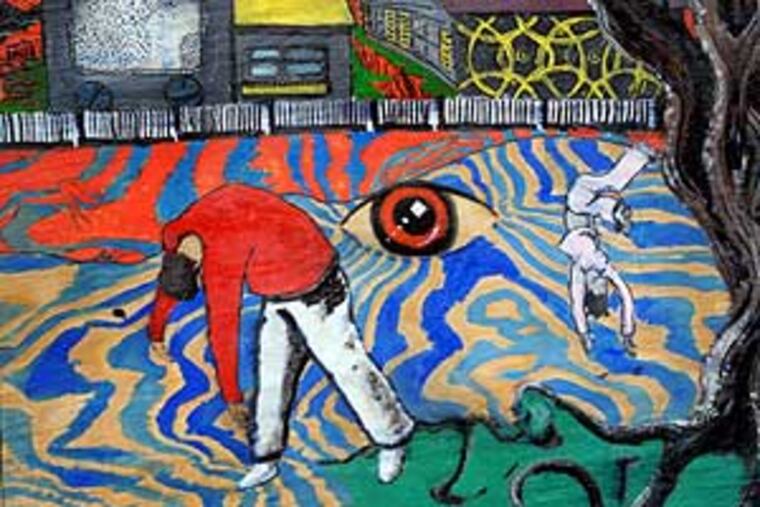A surreal streetscape in Camden
Like a red rose growing out of a sidewalk crack, there's an improbable break in the monotonous, gray cityscape of abandoned buildings on Camden's Market Street.

Like a red rose growing out of a sidewalk crack, there's an improbable break in the monotonous, gray cityscape of abandoned buildings on Camden's Market Street.
An installation of 19 pieces of surrealist art - odd, quirky and delightful - now hangs on the boarded-up facade of a who-remembers-what building between Second and Third Streets.
Created by Rutgers University-Camden students under the direction of fine arts associate professor Elizabeth Demaray, the works are inspired by the artists' dream journals.
A few paintings also incorporate unusual shapes and lines from tracings collected in Camden, urban details that no one really sees.
"It's all very surreal," joked painting instructor Bruce Garrity, on hand this week to assess the work. Several of the student artists were on the street, too, shivering in a swirling wind and admiring the alfresco gallery that will hang through Monday.
Judging from their art, these kids may have eaten too much pepperoni pizza before bedtime. Then again, surrealism is supposed to be more amped up than the Mona Lisa.
In one painting, Tom Hanks is dressed as Sir Lancelot, preparing to protect actress Dakota Fanning from zombies under the watchful eye of a bellicose Zeus, the capo of all Olympian gods.
The work is based on a dream that junior Matthew Mushall, from the Columbus section of Mansfield Township, Burlington County, had about a camping trip with his uncle. Zeus' face actually started as random lines Mushall found in a piece of gravel on a Camden street.
Another piece shows a pickle shooting a gun at a cat. The origin of that one is too difficult to explain.
Still another piece, by Russian-born senior Polina Tolkacheva, is a mirror with fire and pyramids painted on its surface. The work also includes a tracing of a chipped Camden crosswalk.
"I dreamed of the fire, which represents emotion," said Tolkacheva, of Runnemede. "The crosswalk makes me think of all the people who stepped on it."
The exhibit and the students' descriptions excited Demaray, who is clearly proud of their output.
"We did something like this last year, and nobody vandalized our paintings," said Demaray, a sculptor who divides her time between her Camden classroom and her studio in New York. In fact, she said, some community residents added their work to the exhibit.
"I attempt to encourage outreach from the university to the community," she said.
Not one to create in an ivory tower, Demaray likes to include Camden in her work.
"People in Camden don't interact much with the university, and most people here don't talk to each other on the streets," she said.
In 2005, Demaray remedied both problems by having her students knit sweaters for trees on Cooper Street.
"It was something unexpected," she said, laughing. "People were talking to each other on the street then."
Using the rubbing technique known as frottage, German surrealist Max Ernst often used tracings and etchings of sidewalk cracks in his work, Demaray said, explaining the students' assignment. Ernst contemplated the random lines and saw images in them. Surrealists also used a great deal of dream imagery, Demaray said.
Art is nothing without an audience to admire and criticize it, and that's what happened Tuesday when a couple of passersby on the isolated street stopped to study the works.
"Oh, it's not my flavor. I'm more traditional," said Fran McCarrerty of Mullica Hill. "But why not? It's better than seeing graffiti."
Kenny Beasley, a Camden resident, agreed. "Everything is abandoned around here," he said. "This at least gives people something to look at."